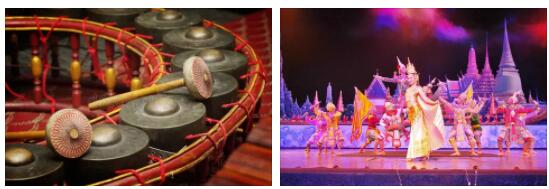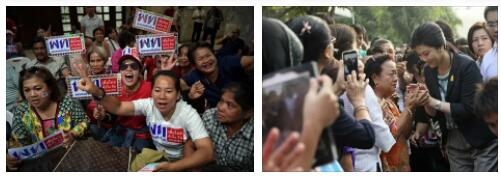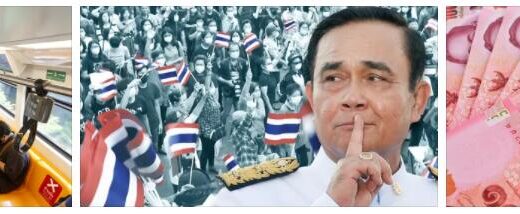Thailand Arts and Music
Thailand’s culture has always been shaped by global influences – in the past by Indian Hinduism and Buddhism, under the reform-oriented kings Mongkut and Chulalongkorn by western modernity, today by globalized consumer culture. The social development as an independent nation-state also shaped the development of culture, among other things through the construction of a Thai culture on the basis of king, Buddhism and nation. You should therefore be careful with the many web-based references to “typically Thai”, as they are often static, gender-stereotypical and bring essentialist cultural attitudes with them. Nevertheless, one should know the common social customs in order to be able to behave politely as a farang (the Thai name for western foreigners). This includes, among other things, learning the Wai (greeting form) correctly, behaving more cautiously and modestly, showing oneself respectfully in front of older people or taking another physical understanding (including special meaning of head and feet) into consideration.
Arts
The arts of Thailand are characterized by dynamic relationships between traditional and modern forms. Officially, “national artists” are cured by the Ministry of Education every year. The first winner was King Bhumibol.
Architecture
In addition to the traditional house and temple complexes, one can now admire futuristic buildings in the architecture. Even if modern architecture is usually not influenced by traditional building methods, more ecological approaches are rediscovering forms and principles of the old building culture today.
Literature
In literature, a modern Thai literature developed explicitly against the old classics such as Phra Aphai Mani in the 20th century, which thematized the change in society and was partly socially critical (the “literature for life”). Well-known novels include Geister (1953) by Seni Saowaphong, The Judgment (1982) by Chart Korbjitti, Schlangen (1984) by Wimon Sainimnuan and White Shadow (1986) by Saneh Sangsuk. Contemporary authors in a lively literary scene focus more on the contradictions of urban life in modern Thailand.
Art
Besides the famous handicrafts, contemporary art in Thailand is also very productive and interesting. Well-known artists include Charlemchai Kositpipat, who has become successful with his neo-Buddhist style (and his “white temple” Wat Rong Khun, see picture), the painters Vasan Sittiket, Therdkiat Wangwatcharakul and Jirapat Tatsanasomboon, Rirkrit Tiravanija, who is known for his art installations or the sculptor Rattana Salee. Young artists are always a talking point, and Bangkok has many museums and art exhibitionsto offer. State-sponsored cultural centers, which are often ideologized by monarchists, include the Bangkok Art and Culture Center, BACC, and the Thailand Creative & Design Center, TCDC. But the capital also has a vibrant art scene that meets in bars, galleries or the alternative and political art scene. A lot comes together in the Bangkok Art Biennale. In recent years the visual arts have also become more political, e.g. in commemoration of the massacre of October 6, 1976, or in exhibitions that are critical of developments in the deal with last years.
Music
In addition to more traditional forms of popular music, Thai musicians are constantly developing new forms of music, which often arise in interaction with foreign musical currents. The different styles of Thai music are closely linked to social origins and questions of identity and political orientation. Thailand has a very active music scene that is constantly generating new bands. For the upper class, the traditions of the earlier courtly musical performances are important, as are the rather mediocre compositions of the late King Bhumibol. The working class and peasants, on the other hand, like to hear Lukthung and Molam. The latter is a traditional style of music from the northeast, in which the khen – a bamboo harmonica – plays an important role. Molam is often played live in the villages and at celebrations in Isan, but it also manages to reinvent itself again and again. Lukthung likes to address the experiences of migrants from the Isan, such as social injustice or homesickness in the distance. It is the genre of music most closely associated with the Red Shirt movement. The songs for life (Plaeng Phuea Chiwit), a musical genre that emerged in the 1970’s as a kind of Thairock of protest culture, are also very well known. Well-known musicians like Ed Carabao or Caravan combine rock music with Thai sounds and socially critical content. The political polarization between red and yellow shirts has also captured music. Thai rap music also has a political orientation. Above all, the “Rap Against Dictatorship”, which landed an Internet hit with its 2018 song “Prathet Ku Mi” (Mein Land). The music video, which criticizes the military regime head-on and connects to the 1976 Thammasat University massacre, was viewed over 17 million times in the first week after it was published. After almost a year, 72 million people viewed it on YouTube. The politicization of the younger music scene now continues with the group”Metal against Dictatorship”. The band Faiyen (“cold fire”), who had to go into exile because of songs critical of the monarchy such as “112 Royal Pizza”, also became famous. After several murders of activists in exile in Laos, they feared for their lives. Fortunately, they were granted asylum in France in 2019. The band continues to operate from abroad to fight for democracy with their music. Rap Against Dictatorship has returned with the song “Reform”, which shows solidarity with the recent protest movement.



